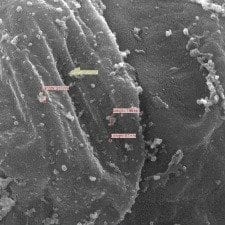
TAU targets drug-resistant ovarian tumors with nanotechnology
Ovarian cancer accounts for more deaths of American women than any other cancer of the female reproductive system. According to the American Cancer Society, one in 72 American women will be diagnosed with ovarian cancer, and one in 100 will ultimately die of the condition.
Now Prof. Dan Peer of Tel Aviv University‘s Department of Cell Research and Immunology has proposed a new strategy to tackle an aggressive subtype of ovarian cancer using a new nanoscale drug-delivery system designed to target specific cancer cells. He and his team — Keren Cohen and Rafi Emmanuel from Peer’s Laboratory of Nanomedicine and Einat Kisin-Finfer and Doron Shabbat, from TAU’s Department of Chemistry — have devised a cluster of nanoparticles called gagomers, made of fats and coated with a kind of polysugar. When filled with chemotherapy drugs, these clusters accumulate in tumors, producing dramatically therapeutic benefits.
The objective of Peer’s research is two-fold: to provide a specific target for anti-cancer drugs to increase their therapeutic benefits, and to reduce the toxic side effects of anti-cancer therapies. The study was published in February in the journal ACS Nano.
Why chemotherapy fails
According to Prof. Peer, traditional courses of chemotherapy are not an effective line of attack. Chemotherapy’s failing lies in the inability of the medicine to be absorbed and maintained within the tumor cell long enough to destroy it. In most cases, the chemotherapy drug is almost immediately ejected by the cancer cell, severely damaging the healthy organs that surround it, leaving the tumor cell intact.
But with their new therapy, Peer and his colleagues saw a 25-fold increase in tumor-accumulated medication and a dramatic dip in toxic accumulation in healthy organs. Tested on laboratory mice, the gagomer mechanism effects a change in drug-resistant tumor cells. Receptors on tumor cells recognize the sugar that encases the gagomer, allowing the binding gagomer to slowly release tiny particles of chemotherapy into the cancerous cell. As more and more drugs accumulate within the tumor cell, the cancer cells begin to die off within 24-48 hours.
“Tumors become resistant very quickly. Following the first, second, and third courses of chemotherapy, the tumors start pumping drugs out of the cells as a survival mechanism,” said Prof. Peer. “Most patients with tumor cells beyond the ovaries relapse and ultimately die due to the development of drug resistance. We wanted to create a safe drug-delivery system, which wouldn’t harm the body’s immune system or organs.”
The Latest on: Ovarian cancer
[google_news title=”” keyword=”Ovarian cancer” num_posts=”10″ blurb_length=”0″ show_thumb=”left”]
via Google News
The Latest on: Ovarian cancer
- Johnson & Johnson moves forward with $6.475 billion settlement of talc cancer lawsuitson May 1, 2024 at 5:00 pm
(CNN) — New York (Reuters) — Johnson & Johnson is moving forward with a $6.475 billion proposed settlement of tens of thousands of lawsuits alleging that its baby powder and other talc products contain asbestos and cause ovarian cancer, the ...
- Johnson & Johnson’s latest gambit to solve its massive talcum powder asbestos issue: A $6.5 billion settlement, paid out over 25 yearson May 1, 2024 at 12:48 pm
J ohnson & Johnson has a multibillion-dollar problem with its talcum powder and it just admitted that the best solution is also a multibillion-dollar one. The pharmaceutical giant, J&J for short, proposed a new way to settle thousands of pending lawsuits that allege its talc-based products,
- BRCA-Like Classification May Be a Useful Biomarker for Olaparib Response in Ovarian Canceron May 1, 2024 at 11:33 am
Adding olaparib to maintenance therapy with bevacizumab was associated with significantly longer survival for patients with ovarian cancer whose tumors have a BRCA-like genomic profile, but not among those with non-BRCA-like tumors,
- Liz Truss visits Parliament with Downham Market woman Diane Boothby to raise awareness of ovarian canceron May 1, 2024 at 7:36 am
Liz Truss has become a champion for the Target Ovarian Cancer charity in a bid to reduce the death toll brought on by the disease.
- J&J Seeks Backing for $11 Billion Baby Powder Cancer Dealon May 1, 2024 at 7:23 am
Johnson & Johnson will ask thousands of people suing over its allegedly tainted baby powder to vote for a settlement that would resolve all litigation for $11 billion — $2.1 billion more than the company offered last year.
via Bing News









